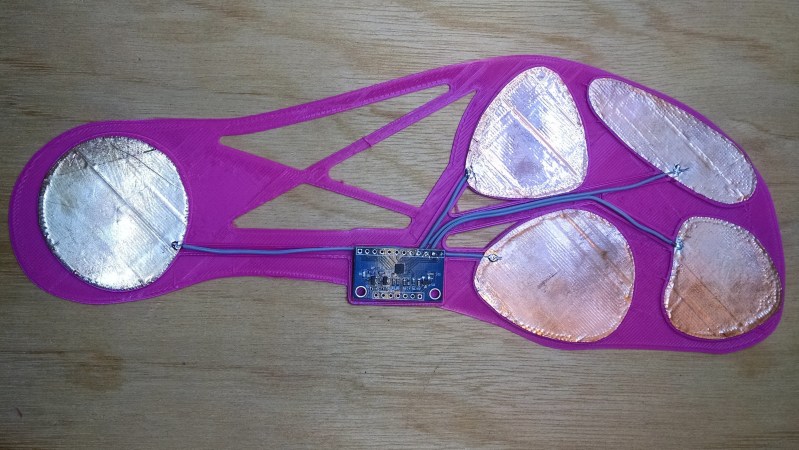Rehabilitating brain injuries where a patient’s sense of balance has been compromised is no easy task. Current solutions only trigger when the patient reaches a threshold and by then, it may already be too late for a graceful recovery. [Simon Merrett]’s SoleSense is being designed to give continuous feedback like a stock humans innate sense of balance. Therapists hope this will aid recovery by more closely imitating what most of us grew up with.
SoleSense relies on capacitive sensors arranged under the feet to know where the patients are placing their weight. [OSHPark] is providing the first round of flexible PCBs so some lucky sole is going to get purple inserts.
Outside of recovery, devices like this can teach better posture or possibly enhance a fully functioning sense of balance. That could improve physical performance. Who knows, we are finding new ways of perceiving the world all the time.
Remapping senses is a popular assistive technology and sound is ideal for the SoleSense to piggyback because brain injuries are less likely to affect hearing than other senses. Of course, senses can be remapped or even created. You could gain a sense of magnetic north or expand the range of light you can perceive.




















Awesome, my kiddo has Usher syndrome which means she is deaf, losing her vision and has zero vestibular function (balance). She is compensating for the vestibular loss but this device could potentially be adapted to help with balance training.
Nice work!!
This seems to be only half the solution since it monitors force against the foot rather than balance itself. Pairing this with a “balance sensor” (for example a gyro chip to indicate that a person was standing upright) would provide a feedback loop that would be quite useful.
We don’t know what other inputs will be effective yet, or even what output would be most helpful (currently continuous tone with varying pitch and volume). It would be great to see you join the team on hackaday.io if you have skills related to gyros or IMUs.
Could maybe get higher resolution with resistive sensors, though they’d have to be against bare skin or special socks, because resistance would be lower between two points on a conductor array when greater pressure on that area. Thinking of something on the principle of those simple stripboard rain sensors.
Good thought and please collaborate over on hackaday.io but two points in response as to why we haven’t gone that way yet.
Firstly, the cost of ready made force sensitive resistors is pretty high once we have several per foot. The MPR121 capacitive sensor IC we’re using at the moment supports 12 nodes/plates per foot and the breakout board is only a few £.
Secondly, the resolution is only worth increasing if you can usefully improve your output as a result. So far, the MPR121 readings are across a range which is greater than both the volume control digital potentiometer and the frequency range of the tones, so I don’t think there is much of a drive to try for higher resolution sensors at the moment.
The most interesting aspect of resolution I have discovered so far is that human “persistence of hearing” where a change in pitch sounds “smooth” is much higher frequency than persistence of vision, at around 60Hz.
Right, 2nd point, true.. you might get there if there’s any value in capturing transient and rapid pressure/weight shift, in that you’d see it roll across the foot, rather than it look like a wriggle or something. I guess until you’ve gone a long way with this it won’t be clear if it’s all you need or find you need to know more.